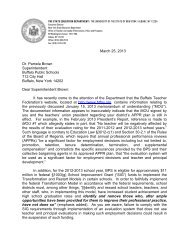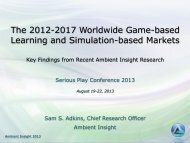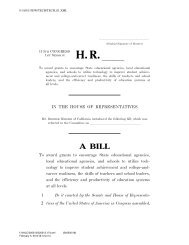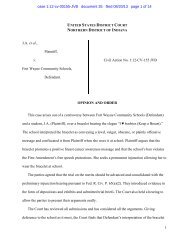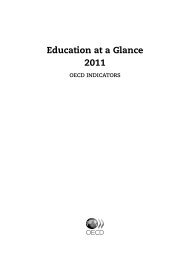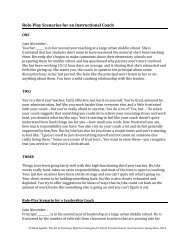Testing More, Teaching Less - American Federation of Teachers
Testing More, Teaching Less - American Federation of Teachers
Testing More, Teaching Less - American Federation of Teachers
- No tags were found...
You also want an ePaper? Increase the reach of your titles
YUMPU automatically turns print PDFs into web optimized ePapers that Google loves.
The <strong>Testing</strong> LandscapeState-mandated testing exploded in the 1990swhen students in selected grades (usually one inelementary, one in middle school and one in highschool) were tested once a year to measure schoolperformance with respect to the nascent “standards”movement. Some research found that the first statesto implement a standards-based reform with statemandatedtesting improved student achievementfaster than non-implementing states (Hanushek andRaymond, 2005). <strong>Teachers</strong> have always supportedhigher standards in large percentages, but they neverfound the end-<strong>of</strong>-year state tests useful for the specificpurpose <strong>of</strong> improving instruction on a day-to-daybasis, preferring instead the formative techniquesand diagnostic tests.The No Child Left Behind (NCLB) law, enactedin 2002, and subsequent federal mandates broughtabout a significant increase in accountability testingby requiring the testing <strong>of</strong> all students in grades3-8 and some grades in high school. The federallymandated tests are used to sanction schools and, inextreme cases, to close some schools or convert themto charter schools. The federal Race to the Top (RTTT)program further fueled high-stakes testing by requiringteacher evaluations to be based in part on studentachievement measured by test scores, as well as onother measures not related to testing. Subsequently,the federal government allowed states to receivewaivers on some <strong>of</strong> NCLB’s test-based sanctions ifthey implemented different test-based sanctions andenacted prescriptive teacher evaluation systems. Thefederal School Improvement Grant (SIG) program alsothreatens schools and staff with job loss, conversion tocharter schools or closure based on student performanceon state and federally mandated tests.Schools use many types <strong>of</strong> assessments. Some arerequired by the state; others are chosen or developedat the district level. Some <strong>of</strong> a district’s student assessmentinventory is linked to federal laws and regulationsother than NCLB. In many respects, given theubiquitous emphasis on data reporting and analysis,nearly every assessment has become a high-stakesassessment with consequences for students, teachersand schools.State-mandated summative tests are designed toassess whether students are meeting state standardsin a given year. Tests are generally conducted in thespring as a means <strong>of</strong> “summing up” what studentsknow that year, which is why these tests are referredto as summative assessments. The results <strong>of</strong> thesetests are tied to the state’s accountability system asmandated by NCLB. When linked to prior-year summativetest scores, student progress can be measured,which provides some information about howwell schools or teachers did in the current testingyear, the true measure <strong>of</strong> school effectiveness. Unfortunately,many states and the federal governmentsanction schools for a single summative test score—a measure <strong>of</strong> student achievement but not schoolor teacher effectiveness—rather than the students’progress, which would show the school’s contributionto learning over the course <strong>of</strong> the school year.Both Midwestern School District (Table 1A) andEastern School District (Table 1B) are implementingnew state end-<strong>of</strong>-course testing in high school. NCLBrequires testing in only one high school grade, butteacher evaluation requirements and tougher careerandcollege-readiness standards in the RTTT andNCLB waiver requirements have supported the pushtoward end-<strong>of</strong>-course assessments.Eastern District students may take as many as 10state-mandated end-<strong>of</strong>-course assessments (algebra1, algebra 2, geometry, literature, English composition,biology, chemistry, U.S. history, world history,civics and government) by the time they finish highschool. Midwestern District students may take asmany as seven state-mandated end-<strong>of</strong>-course assessments(algebra 1, advanced algebra, geometry,English 9, English 10, <strong>American</strong> history, and government).Next-generation summative assessments. ThePARCC- and SBAC-developed Common Core assessments,scheduled for full implementation in2014-15, represent the next generation <strong>of</strong> summativetests. However, they still provide only a snapshot <strong>of</strong>student achievement at a specific point in time andwill be used primarily for accountability purposes.Both the PARCC and the SBAC assessment consortia<strong>Testing</strong> <strong>More</strong>, <strong>Teaching</strong> <strong>Less</strong> 9



